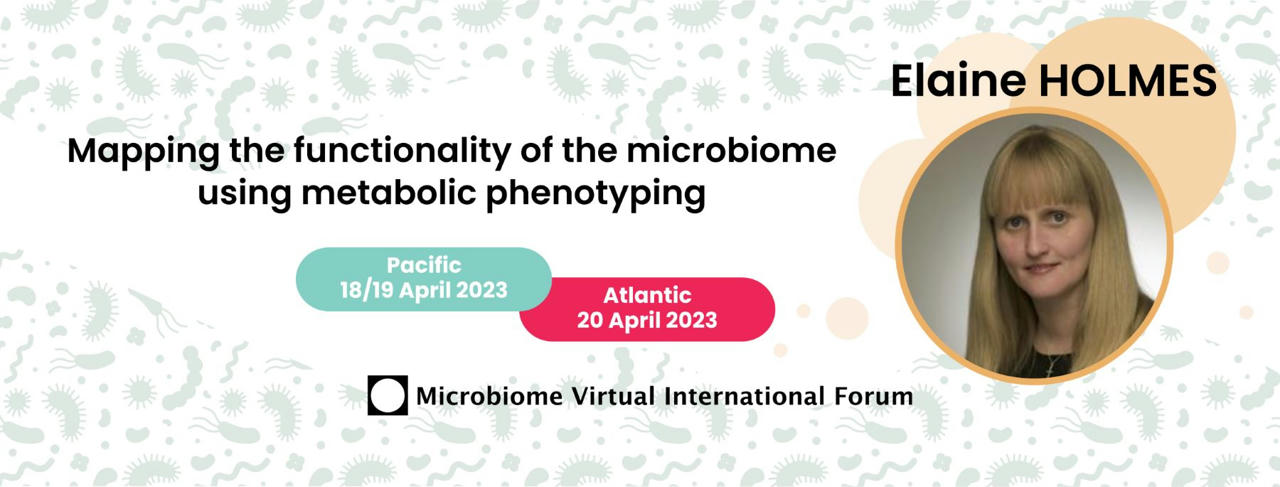Mapping the functionality of the microbiome using metabolic phenotyping
by Elaine Holmes
The contribution of the gut microbiota to human health and disease is undisputed, yet the mechanisms by which the microbiome exerts its effects remain poorly understood. Co-evolution of host and microbiome has influenced the functionality of both the microbiome and host such that metabolic complementarity exists within the microbiota and that critical biosynthetic pathways are provided for the host that significantly extend host metabolic capacity. Of all the ‘omics’ technologies, metabonomics provides one of the most accessible windows on investigating the impact of the microbiome on human health since metabolic profiles of easily obtainable biofluids such as blood plasma and urine carry information relating both to genetic and environmental influences, including microbiome-diet and microbiome-xenobiotic interactions. High resolution spectroscopy together with multivariate mathematical modelling has been used to model the metabolic consequences of perturbing the microbiota and to profile the effects of nutritional interventions on both the metabolism and the microbiome. Basic studies in germ free and antibiotic-treated animals have shown stark changes in the urinary and faecal metabolomes, which are largely restored to ‘normal’ following recolonization. Recent research indicates that the microbial metabolites can be predictive of response to drug treatment and to diet. This presentation describes the use of metabolic profiling to evaluate the impact of the gut microbiome on human health and focuses on applications in early and later life.
Short Bio
Holmes is an ARC Laureate Fellow at Murdoch University, where she runs the Centre for Computational and Systems Medicine in the Health Futures Institute. She obtained her PhD from the University of London in renal toxicology in 1992 and became a lecturer at Imperial College London in 1998 where she became Head of the Division of Computational Systems Medicine. She was awarded the RSC Interdisciplinary Prize for work at interface of medicine and chemistry in 2015 and was elected as a Fellow of the Academy of Medical Sciences in 2018. She has >500 publications with an H index of 134 with >76000 citations (google scholar).
Holmes is one of the pioneers in the development and implementation of metabolic phenotyping in translational clinical paradigms. The analytical framework conceptualised for metabolic phenotyping and biomarker discovery has been applied across several disease areas. She also co-developed the Metabolome-Wide Association Study concept and has shown that the microbial component of the metabolic profile is associated with a wide range of conditions including obesity, inflammatory bowel disease, allergies and certain cancers. She has an interest in metabolic mapping of mammalian responses to infectious diseases and has focussed recently on mapping the response to SARS-CoV-2 infection including exploration of the systems effect of long-covid.
Her work is internationally recognised as demonstrated by her membership of advisory bodies, editorial boards and research panels, extensive keynote and plenary lectures and visiting/adjunct professorial positions.
Short Talks
Evolution of the breastfed infant gut microbiome across the first year of life in the BLOSOM cohort
Background. Assembly of the human gut microbiome during early life is a complex and dynamic process. Aberrations to the early gut microbiome have been repeatedly associated with later-life disease. While previous studies have explored the temporal development of the infant gut microbiome, none have done so in an exclusively breastfed population, nor in an Australian context. Here, we characterized the temporal development of the breastfed infant gut microbiome over the first 12 months of life in the BLOSOM birth cohort.
Methods. Infant stool samples were collected at 2-5 days, and 1, 2, 3, 4, 5, 6, 9, and 12 months of age (n=684 samples from 85 infants). The gut microbiome was analysed using PacBio full-length 16S rRNA gene sequencing.
Results. Exclusive breastfeeding was a strong determinant of the infant gut microbiome, with introduction of solid food driving a rapid and dramatic expansion in the gut community. Richness and Shannon diversity remained stable over the first 5 months of life, followed by a significant increase in diversity from 6 to 12 months (P<0.0001). Bifidobacterium was the dominant genera in this cohort, with Bifidobacterium longum supsp. infantis representing the most abundant species (27% relative abundance across all samples). Bifidobacterium relative abundance increased across the first 4 months of life from a mean relative abundance of 23% at 2-5 days to 46% at 4 months. Bifidobacterium levels then began to steadily decline from 5 to 12 months (12 month mean relative abundance = 33%). The persistence of this health-promoting genera a 12 months of age is likely a reflection of the high breastfeeding retention rates in the BLOSOM cohort (>80% still breastfeeding at 12 months of age). C-section delivery was a major determinant of the infant gut microbiome, with significant impacts on Bifidobacteria and Bacteroides. Similar impacts were seen in vaginally delivered infants whose mothers were exposed to intrapartum antibiotic prophylaxis, suggesting that antibiotic exposure related to delivery mode, rather than delivery mode per se, is responsible for the effect.
Conclusion. In the first study of gut microbiome assembly in exclusively breastfed Australian infants, we demonstrate a high abundance of Bifidobacterium that persists to 12 months of age. Our results also demonstrate the dramatic impact of introduction of solid foods, and exposure to intra-partum antibiotics. These data illustrate “optimal” infant gut microbiome development associated with vaginal delivery and breastfeeding.
Lisa Stinson
School of Molecular Science, The University of Western Australia, Australia
Do you see what I see? Improving color accessibility and organization of microbiome data visualizations with the microshades R package
Background: Color Vision Deficiency (CVD), commonly known as colorblindness, affects approximately 300 million people worldwide. Individuals with CVD do not experience complete loss of color vision, but have reduced ability to distinguish different colors. When creating scientific figures, it is important to consider that individuals with CVD may not perceive all colors as intended. While there are several CVD friendly color palettes available, they are often insufficient for visualizing complex data that is often generated in microbiome studies. Methods: To overcome CVD accessibility for microbiome datasets, we developed an R package, microshades. Microshades includes CVD accessible color palettes and data organization functions. To construct the palettes, hue (type of color), chroma (colorfulness), and luminance (brightness) were adjusted for optimal visual distinction and CVD accessibility. All shades were tested with a CVD simulator (cvdemulator) for accessibility. In addition to accessible color palettes, we also provide data organization functions. These include grouping data by taxonomic ranking, sorting the data vertically and horizontally, and restructuring the plot legends. Results: Each microshades color palette contains six hues with five sequential variations of chroma and luminance per hue, for a total of 30 available colors per palette. The microshades_cvd_palettes colors are universally CVD accessible to individuals with the three most common types of CVD (Deuteranope, Protanope, and Tritanope). The individual hues of the microshades_palettes colors are CVD friendly, but when used in conjunction with multiple hues, may not be universally accessible to all forms of CVD. Discussion: The microshades R package is a visualization tool designed for microbiome researchers. The package contains two CVD accessible palettes, along with several organization features. The microshades package can be used in conjunction with common microbiome R packages, such as phyloseq, to enhance microbiome data visualization.
Link to OA paper: https://doi.org/10.1128/mra.00795-22
Erin M Dahl, Kate R Bowie, Emory Neer, Eric T Leung, Lisa Karstens
Oregon Health & Science University
Genomic analysis of cultivated infant microbiomes identifies Bifidobacterium 2’-fucosyllactose utilization can be facilitated by co-existing species
Human milk oligosaccharides (HMOs) ensure proper infant gut microbiome establishment. Isolate studies have revealed the genetic basis for HMO metabolism, but they exclude the possibility of HMO assimilation via synergistic interactions involving multiple organisms. Here, we investigated microbiome responses to 2'-fucosyllactose (2’FL), a prevalent HMO and infant formula additive, by establishing individualized microbiomes using fecal samples from three different infants as the inocula. Bifidobacterium breve, a prominent member of infant microbiomes, typically cannot metabolize 2’FL. Using metagenomic data, we predicted that extracellular fucosidases encoded by co-existing members such as Ruminococcus gnavus initiate 2’FL breakdown, thus critical for B. breve’s growth. Using both targeted co-cultures and by supplementation of R. gnavus into one microbiome, we show that R. gnavus can promote extensive growth of B. breve through the release of lactose from 2’FL. Overall, microbiome cultivation combined with genome-resolved metagenomics demonstrated that HMO utilization can vary with an individual’s microbiome.
Link to BioRxiv paper: https://www.biorxiv.org/content/biorxiv/early/2023/03/11/2023.03.10.532136.full.pdf
Yue Clare Lou, Benjamin E. Rubin, Marie C. Schoelmerich, Kaden DiMarco, Adair L. Borges, Rachel Rovinsky, Leo Song, Jennifer A. Doudna, Jillian F. Banfield
Presenting author’s affiliation: Department of Plant and Microbial Biology, UC Berkeley & Innovative Genomics Institute, UC Berkeley, California, USA
The microbial and metabolic landscape of infant cystic fibrosis: the gut-lung axis
Background and Aims: In cystic fibrosis (CF), gastrointestinal dysfunction and lower airway infection occur early and are independently associated with poorer outcomes in childhood. This study aimed to define the relationship between the microbiota at each niche during the first 2-years of life, its association with growth and airway inflammation, and explanatory features in the metabolome.
Methods: Sixty-seven bronchoalveolar lavage (BAL), 62 plasma and 105 stool samples were collected from 39 infants with CF between 0-24-months who were treated with prophylactic antibiotics. 16S rRNA gene and shotgun metagenomic sequencing were performed on BAL and stool respectively; metabolomic analyses were performed on all sample types. Sequencing data from healthy age-matched infants were used as controls.
Results: Twelve genera were common to stool and lower airway; the respective relative abundance of Veillonella and Pseudomonas at each site were correlated. Veillonella formed part of the core stool microbiota, consistently present and associated with airway α-diversity, while Pseudomonas was detected only intermittently at each site. In the CF gastrointestinal tract, α-diversity was reduced, microbial maturation was delayed, and Proteobacteria were increased, and differences between CF and health increased with age. Forty-two metabolites were detected in gut, plasma and lung and relationships to airway inflammation and growth were identified. Conclusion: Differences in the CF gastrointestinal microbiota increased with age. Pseudomonas DNA in stool reflected its presence in the lower airway. The clinical utility of stool as non-invasive screening for this significant airway pathogen demands further evaluation.
Katherine Frayman
The Royal Children's Hospital Melbourne

